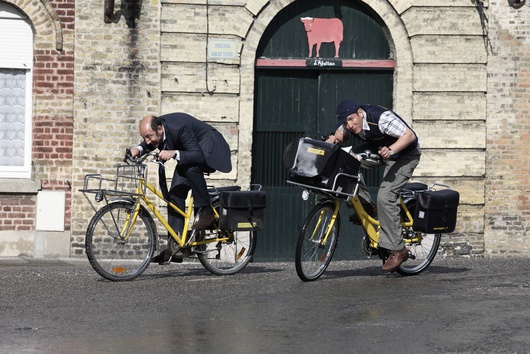
‘Ch’tis’: most successful French film since 1945
Published on
Translation by:
 Luise Franke
Luise Franke
One million more tickets, and ‘Bienvenue chez les Ch’tis’ (‘Welcome to the Sticks’) will become the most successful film in France since 1945. Can the French comedy break all box office records?
The French press is enthusing: finally a film emerges which is a genuine one-off. Comparisons to such success stories such as Le Père Noel est une ordure (‘Santa Claus Is a Louse’, 1982) and Les Bronzés font du ski (‘The Bronzes Go Skiing’, 1979) are being lauded. Bienvenue chez les Ch’tis (‘Welcome to the Sticks’) is a roaring success. Attention on the former coal mining district of Nord-Pas de Calais now runs beyond the Eurostar link, and the column inches and television airtime being dedicated to the film, which premiered on 27 February in France, are still considerable. Talk is now turning to launch the film in the rest of Europe, but debate is raging as to whether the northern French ‘Ch’ti’ or Picard dialect should be replaced by Saxon, north Italian and Asturian to achieve similar level of success.
Can the Titanic sink twice?

Bienvenue chez les Ch’tis has experienced such rapid success in France that it has catapulted into the ranks of the most successful films since 1945. To date, almost 20 million people have seen the regional comedy about the much-maligned northern region of France since its release. Such popularity has seen the 1966 film La grande Vadrouille (‘Don't Look Now - We're Being Shot At’, 1966), starring Louis de Funès, displaced from its record breaking position. However, at the present, just one million ticket sales need to be sold for the record set by the US blockbuster Titanic (1997) to be surpassed.
A project from the fringes, the script was penned by comedian and local boy Dany Boon, who, on a budget of just 11 million euros, plays one of the leading protagonists and directed the production. That’s somewhat a shoestring in comparison to the last Asterix film, with its coffers of 100 million euros.
The role of post office manager is played by Kad Mera, whose dream transfer from provincial southern France to the heavenly Côte d’Azur goes somewhat awry as he arrives in the small town of Bergues (pronounced ‘Beark’), in the Nord-Pas de Calais region. To add insult to injury, all the inhabitants of the town speak ‘chtimi’, a pleasant but somehow forceful sounding dialect. For employees with their roots and hearts in the south, the result is a sheer nightmare and the cultural shock as plates of north-south stereotypes collide is palpable. Nevertheless, as the French saying goes: in the north you cry twice: upon arrival and departure.
A ch’ti on Rügen Island
 Whether Bienvenue chez les Ch’tis can continue its success in Europe has divided opinion – it went out on limited release in the UK on 1 April, and goes out in Germany in autumn 2008. Can the Saxon or northern Italian dialects, with their extended expression, a facet demanded by the sound of the Ch’ti, suffice? Can Bergues be presented as a small town in Saxony? Why not. Boon isn’t so well known outside of France that he could be affiliated to a specific nationality, voice or dialect. The architecture of northern France is not unseen in other areas and the post office is a ubiquitous institution (albeit not always with a yellow livery). Regional differences are a hot topic at present: prime examples are abound in Italy’s Lombardy and Campania regions, in Andalusia and Catalonia in Spain and in Germany between Bavaria and Saxony.
Whether Bienvenue chez les Ch’tis can continue its success in Europe has divided opinion – it went out on limited release in the UK on 1 April, and goes out in Germany in autumn 2008. Can the Saxon or northern Italian dialects, with their extended expression, a facet demanded by the sound of the Ch’ti, suffice? Can Bergues be presented as a small town in Saxony? Why not. Boon isn’t so well known outside of France that he could be affiliated to a specific nationality, voice or dialect. The architecture of northern France is not unseen in other areas and the post office is a ubiquitous institution (albeit not always with a yellow livery). Regional differences are a hot topic at present: prime examples are abound in Italy’s Lombardy and Campania regions, in Andalusia and Catalonia in Spain and in Germany between Bavaria and Saxony.
But in the age of European integration, where does the recipe of success lie in this cinematic regression to a world of tradition and regional dialects? The fact that globalisation is developing alongside a growing tendency towards regionalism has long been prevalent. The faster one travels around the globe via the power of the internet, the more people are digging into their immediate environment, language and identity.
Can Europe converge more smoothly without these regional barriers? Can’t we all think a little more ‘European’? The EU actively chose the mottoUnited in Diversity, and every country exhibits a rich diversity which it considers worthy of preservation. Such thoughts are stronger than ever before thanks to European subsidiarity. The feeling of being a European Bavarian or a European of Breton is not necessarily a paradox, but possibly the only possibility to facilitate European and regional integration. Nevertheless, ingrained stereotypes about neighbours and fellow citizens seem to resurface constantly.
Although the debate over the intellectual weight of the film rumbles on, in the end the peculiarities over regional differences evokes a renewed understanding and curiosity. In contrast, the last truly European film Asterix seems a little superficial.
Translated by Zoë Brogden
Translated from Europa spricht Ch'ti?


